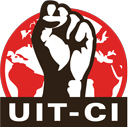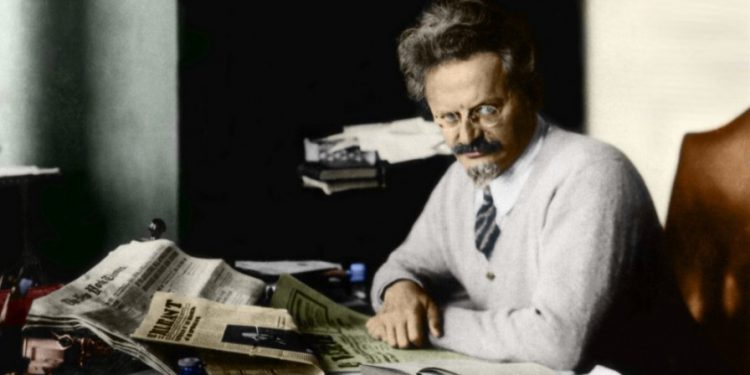By Federico Novo Foti – extract from the article published in https://uit-ci.org/index.php/2022/08/18/el-21-de-agosto-de-1940-leon-trotsky-era-asesinado-por-un-agente-estalinista/
Trotsky was one of the foremost revolutionary leaders of the 20th century. He led the first triumphant socialist revolution in history alongside Lenin in Russia. His name is associated with the struggle for socialism, workers’ democracy and internationalism. With his assassination, Stalin tried to cut off the historical continuity of the revolutionary workers’ struggle. But his legacy lives on.
(…)
Trotsky’s assassination was the culmination of a relentless pursuit that began in 1927 with his banishment from Russia, his forced exile by “the visa-free planet” and the murder or confinement of his followers, collaborators and family members. The cause of his persecution lay because, from the mid-1920s, Stalin had consolidated his bureaucratic power in the USSR. From 1924 he imposed the non-Marxist conception of “socialism in one country” and, from 1935, the “popular fronts” of capitulation to the bourgeoisie in all the communist parties of the Third International. (1)
A Life Devoted to Socialist Revolution
Leon Davidovich Bronstein, Trotsky, was born on 26 October 1879 in a village near Odesa in Ukraine, a region then subject to the Tsarist empire of Russia. At a very young age, he became a Marxist. The tsarist regime quickly imposed imprisonment and deportation to Siberia. He joined the Russian Social-Democratic Workers’ Party after his first escape from Siberia, joining the organisation led by Lenin. In the 1905 revolution, he was the top leader of the St. Petersburg Soviet, the capital of the empire. After the defeat of the revolution, they deported him to Siberia together with the Soviet leaders, from where he escaped in a reindeer sledge, the adventures of which he recounted in the book “Round Trip” of 1907, now republished to great acclaim. (2) In his assessment of the 1905 revolution, he first set forth his “theory of permanent revolution”. He asserted that the workers of the cities, leading the poor peasantry, not the bourgeoisie, were the only class capable of leading the bourgeois-democratic revolution and, by seizing power, advancing towards socialism by transforming the conditions of life in the countryside and the cities. Trotsky was also part of the internationalist minority who, along with Lenin, Rosa Luxemburg and Karl Liebknecht, rejected the betrayal of the Second International when it supported the inter-imperialist war in 1914 and predicted that “the coming years will witness the era of social revolution”.
In February 1917, a revolution broke out in Russia. After the collapse of the tsarist regime, a coalition of the liberal bourgeoisie and reformist parties took over the government. But, alongside it, the soviets re-emerged in defiance of its power. Trotsky returned to Russia in May, was incorporated into the leadership of the Petrograd (formerly St. Petersburg) Soviet and joined Lenin’s Bolshevik Party. The revolution allowed a rapid convergence between the two leaders. Lenin had got the party not to give its support to the bourgeois provisional government but to take up the fight for a workers’ government, supported by the peasants, which would be the prelude to the international socialist revolution. The Bolsheviks, with Lenin and Trotsky, gained more and more weight and achieved a majority in the soviets, and were the only ones who consistently defended the interests of workers, peasants and soldiers. Finally, Trotsky was appointed head of the Military Revolutionary Committee of the Soviets, which organised the seizure of power on 24 October, consummating the first triumphant socialist workers’ revolution in history.
His legacy lives on
In the government of the soviets, Trotsky held various posts and led the Red Army, which defeated the White Army, the coalition of imperialist armies, in the civil war. After Lenin’s death in 1924 and the consolidation of the bureaucratic apparatus, he led the Left Opposition against the abandonment of the revolutionary programme by the Stalinist bureaucracy. After the rise of Nazism in Germany in 1933 enabled by the Stalinist policy of splitting the workers’ movement, Trotsky concluded that the Third International was dead and a new world organisation had to be founded. In 1938, still under terrible conditions of persecution, Trotsky set about one of the most important challenges of his life: the founding of the Fourth International, the party of the world revolution, to continue the red thread of a revolutionary struggle. Its programme, the “Transitional Programme”, stated that under decadent capitalism, “the crisis of humanity is reduced to the crisis of its revolutionary leadership”. Shortly afterwards, Trotsky would be assassinated, dealing a severe blow to the Trotskyist movement and aggravating a crisis of revolutionary leadership that continues to this day.
Eighty-two years after Trotsky’s assassination, imperialism continues to condemn millions to poverty and destitution across the globe during the biggest economic crisis in the history of capitalism and Putin’s war of occupation in Ukraine. But the people are rebelling, leading heroic struggles and revolutions that are defeating the austerity plans and even overthrowing bourgeois governments. Faced with the siren songs of false socialism that lead workers and peoples to new frustrations and defeats, the Socialist Left and the International Workers’ Unity – Fourth International (IWU-FI) vindicate Trotsky’s revolutionary trajectory, the importance of the founding of the Fourth International and the still valid need to build revolutionary parties in all countries. On the road to rebuilding the Fourth, we call to unite revolutionaries against imperialist capitalism and bourgeois governments, in defence of the rights of the workers and other popular sectors, to develop mobilisation and to win through triumphant revolutions workers’ and popular governments that build real socialism throughout the world.













